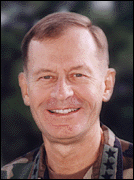

![]()
Gathering Places


![]()
Gathering Places
AS THE STRATEGIC requirements for U.S. military forces have shifted in the Pacific and Asia, the Army plans to field new fighting formations that will enable the Commander-in-Chief Pacific (CINCPAC) to deploy a more lethal, agile force more rapidly and with greater expectation of decisive results in war or peace once soldiers put their boots on the ground. Army plans more
lethal, agile force as new
Pacific strategy takes shapeMILITARY MATTERS
To achieve this, the Army will transform a light infantry brigade in Hawaii and one in Alaska to "interim brigade combat teams" to continue on a path of modernized capabilities and higher value-added contributions to assigned missions.
Transformation in the Army is a process of profound change, a series of linked steps that anticipate future Pacific, and worldwide, requirements and missions. It is far more than just a change of equipment and organization. It fills a gap between present Army heavy-force lethality and survivability and light-force deployability and versatility. It leverages the interim brigades to help evolve training and develop leaders ready to apply lessons learned and forge a much more capable Army over the next decade.
Changes will affect every part of the Army, from types and use of troop units to installation management and related support facilities. Capabilities gained will enable new units to operate on terms more favorable to them, whether related to war-fighting or stability operations. Knowledge-based systems, all connected, will help these units see, understand, and act first, a critical advantage in response to conflict.
Linked information, communications, weapons and mobility systems as well as supporting bases will guarantee better capabilities, and better-led and trained troops, as our Army today and tomorrow postures for missions ahead, those foreseen and those that may be around the corner.
Along with the rest of the Army, Army commanders and staffs in Alaska and Hawaii have been identifying requirements for receiving, housing, training, employing these units and developing leaders to lead them. New facilities and support areas will be needed. Everywhere that we intend to put these units, we will be conducting detailed environmental analyses to ensure that we make good decisions and continue to support environmental partnerships we have worked hard to develop with our neighbors.
The Army ahead remains our Army, ready to defend our collective security interests as well as to set an example of competence and values in which all take pride and have confidence.
Change will not happen overnight. For example, while there will be an increase in military vehicles here, these vehicles will normally use to-be-developed post and training area roads to avoid adding traffic on civilian roads.
With new weaponry, gunnery ranges at some locations will require reconfiguration to meet qualification standards. Such shifts in training areas will occur only where logical as we remain committed to using all areas in an environmentally responsible manner and ensure the readiness of our forces. Deployments from home stations will also be optimized, which will reduce stress on the environment.
We aim to have the right people and facilities to support the mix of present and newly forming forces. Privatization of parts of our supporting structure may play a role but only where merited as cost effective and by common sense. We will aggressively seek fair, long-term solutions that exploit best business practices and sustainable approaches to modernizing all facilities as fast as available funds permit.
The Army has placed new emphasis on Pacific-postured but worldwide deployable Army capability within this region, seizing an opportunity to link readiness and modernization to set an example, deter aggression and promote peaceful development in the Asia-Pacific region.
We are confident that our strong partnership with the citizens of Hawaii and Alaska will continue during this transition.
Lt. Gen. Ed Smith commands the U.S. Army Pacific
from his headquarters at Fort Shafter.